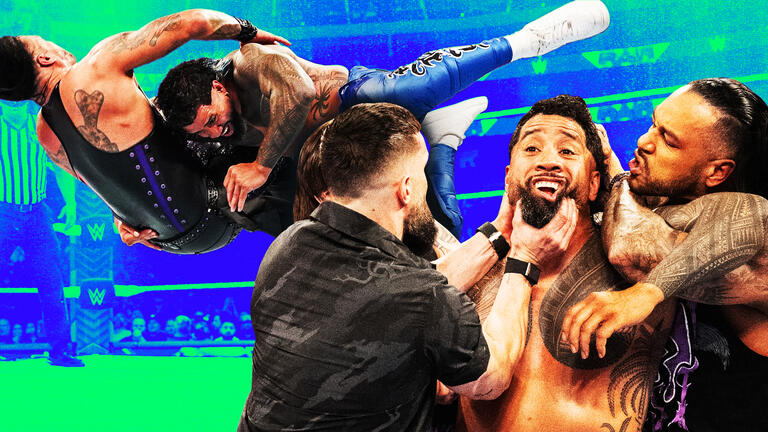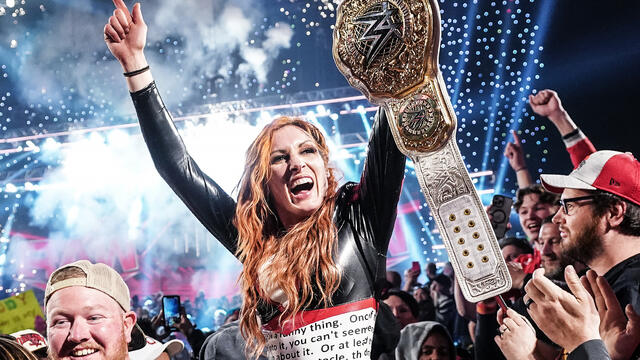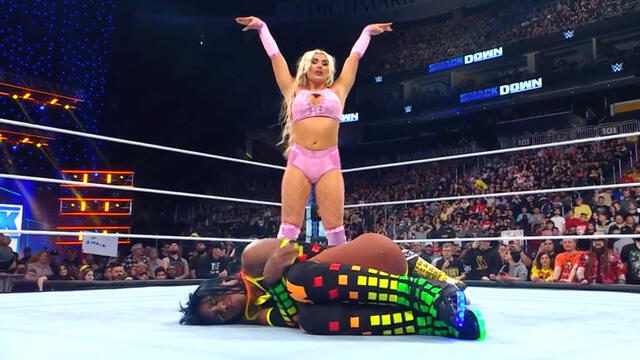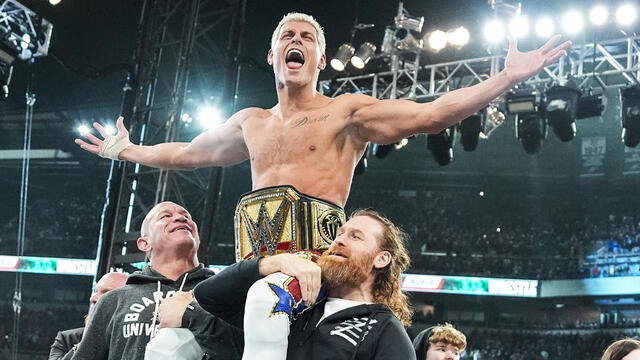
Wrestling's favorite restaurant: The oral history of Ribera Steakhouse

How did a hole in the wall on a Tokyo strip become the most famous restaurant in the world of professional wrestling? Go inside Ribera Steakhouse and hear from the competitors that have earned the eatery's legendary satin jackets.
Glance through any photo album from wrestling’s older days, and chances are you’ll spot the most legendary competitors in the history of the squared circle wearing a satin jacket with a small bull logo on the breast. No, grapplers like Terry Funk and Bruiser Brody weren’t shopping at the same clothing stores — they were eating at the same restaurant.
The culinary landscape may boast top names like Anthony Bourdain, Wolfgang Puck and Bobby Flay, but the wrestling world has Japan’s Ribera Steakhouse. For more than 30 years, wrestlers have made the traditional pilgrimage to a tiny eatery in a busy Tokyo neighborhood. And for a chosen few, the restaurant’s owners have bestowed upon them the mythical and highly-desirable Ribera Steakhouse jacket.
But how did a hole in the wall across the Pacific serving simple steak dinners become a sports-entertainment institution? WWEClassics.com chewed the fat with the men who’ve been there, eaten the steak and worn the jackets, including current Superstars, revered legends and independent wrestlers to get the skinny on The Land of the Rising Sun’s most famous steakhouse.
The Players:
- JOHN CENA – The WWE Champion once wore a Ribera jacket to the ring during a Live Event in Japan.
- CHRIS JERICHO – The first-ever Undisputed Champion went to Ribera Steakhouse long before arriving in WWE while perfecting his craft overseas.
- CM PUNK – The longest-reigning WWE Champion of the last 25 years grew up idolizing the Superstars he saw wearing Ribera jackets.
- ANTONIO CESARO – A grappler with a cult following, Cesaro visited Ribera while plying his trade before coming to WWE.
- WADE BARRETT – The former Intercontinental Champion recently boasted on Twitter about receiving his first Ribera jacket.
- JUSTIN ROBERTS – WWE’s longtime ring announcer recently received his first Ribera jacket after growing up a huge wrestling fan in Chicago.
- WILLIAM REGAL – One of wrestling’s most respected veterans, Regal first ate at Ribera more than 20 years ago.
- COLT CABANA – Known briefly in WWE as Scotty Goldman, CM Punk’s best friend still visits Ribera during his stints with Japanese wrestling organizations.
- TOMMY DREAMER – The ECW icon first visited Ribera in the ’90s with a crew of other ECW Originals.
- ROAD WARRIOR ANIMAL – One half of The Road Warriors, Animal is often credited with creating the famed Ribera jacket and Zubaz outfit pairing.
- STAN HANSEN – Feared across continents, the former AWA Champion broke Bruno Sammartino’s neck before becoming a wrestling legend in Japan.
View photos of the legendary steakhouse and competitors wearing the jackets
JOHN CENA: It’s tradition that when you go to Japan, you go to Ribera. I don’t even know where the folklore starts, but the family that owns the place has always been traditionally hospitable to wrestlers. The food’s great. They treat us with the greatest hospitality.
WILLIAM REGAL: I don’t know where the tradition comes from. Probably because it was one of the few places you could get a steak in Japan.
STAN HANSEN: In Japan back in the late ’70s, early ’80s, steak was still foreign. It was very expensive. Just to get a normal steak was $20 or $30. Wrestlers had a hard time finding a place to eat fairly cheap and everybody loved steak, coming from America. Bruiser Brody happened to find this place. He took me soon after he found it. Probably ’78 or ’79. The [owner] was a wrestling fan and became a bigger fan as more and more guys came to eat. He treated everybody really good. He gave us a few little discounts and would pile the food on for everybody. [The owner] became known as Ribera, but I don’t know what his real name was.
ROAD WARRIOR ANIMAL: They take care of the wrestlers. If it’s your first time there, steak’s on the house and they help you out all the other times.
HANSEN: It became very popular. People would come to Japan and say, “I want to go to Ribera.” And I’d go, “God, why?” [laughs] I mean, the steak was okay, but I think it was more for atmosphere and so everybody could enjoy themselves there and be a little wild and crazy.
Eventually, wrestlers wanted to visit Ribera for reasons other than a meal and a good time. They wanted to get their hands on one of the steakhouse’s prized satin jackets. It may have been Bruiser Brody and Stan Hansen that made the meals popular, but it was a bruising tag team from Chicago that brought the jackets to prominence.
ANIMAL: Ribera’s a good friend of mine. We exchanged gifts a lot of times. I would give him gifts for his wife and family and he would give me gifts for my wife and family. He gave me the Ribera Steakhouse jacket. We weren’t the only ones. A lot of guys would wear the Ribera Steakhouse jackets, like Brody, Hansen and the Funks, but Hawk and I were probably the first world-renowned guys who wore them. We wore Ribera Steakhouse jackets everywhere.
CENA: It became a rite of passage for the American guys to go, after a few tours in Japan, and receive the ever-famous Ribera jacket.
COLT CABANA: It meant that you were good enough to wrestle in Japan. It’s a level of respect. You’re a guy that’s done your work and it’s proven by having this jacket.
CHRIS JERICHO: When I first started, you weren’t an official wrestler unless you had a Ribera jacket, which is basically this cheesy, rayon, faux-satin jacket with an ironed-on Ribera Steakhouse logo on it. But if you had one of those, it proved you were a wrestler who’d been to Japan. You’d see all guys wearing them, whether they were the biggest stars or had been to Japan once. It was like a badge of honor.
CM PUNK: The first person I ever saw with a Ribera Steakhouse jacket was Terry Gordy. These guys used to wear their Ribera Steakhouse jackets as ring jackets. When you’re a kid, you don’t think about sponsorships and getting free steaks and extra money, you just think, “Whatever this guy’s wearing, it’s badass.”
REGAL: There was a team of British wrestlers I wanted to be a part of when I was teenager, called The Internationals — Pete Roberts, Terry Rudge, Dave Taylor. They’d walk into the locker room and most of them wore their Ribera jacket. It set them apart from everybody else.
JUSTIN ROBERTS: When I was 11 or 12 years old, I used to wait outside the Rosemont Horizon — now the Allstate Arena in Chicago — and wait to take pictures with all the Superstars as they were coming in. If you look back at my photos, it was myself with a Superstar in a Ribera satin jacket. Kamala, The Undertaker, everybody.
WADE BARRETT: When I first started off as an independent wrestler in ’04, I met a guy named Brody Steele, who wrestled around the world. He always walked around wearing a Ribera Steakhouse jacket. He told me that any wrestler who makes it in the world of wrestling ends up with one of these. I knew one day I needed to get mine. It’s something that is a big deal when you finally do get it.
PUNK: It turned into this prize, almost a goal for wrestlers going to Japan, to get your Ribera Steakhouse jacket.
TOMMY DREAMER: The first time I went to Japan, I went for All Japan Pro Wrestling with “Dr. Death” [Steve Williams], Tommy Rogers and Phil LaFon in 1994. They all took me there and I wasn’t worthy of getting a Ribera jacket.
CABANA: I have two jackets. I have a silver one with black trimming and a black one with red trimming. I first got one in 2006 when I went to Japan for ZeroOne. Years later, I went back to Japan for Pro Wrestling NOAH and they gave me another jacket. On my last tour, they gave me the Zubaz pants. So, hanging on my wall is the Ribera jacket and the Zubaz pants together as a piece.
JERICHO: I have about five of them in my closet. This last time we went, I didn’t even get one. There’s only so many Ribera jackets that you need. The first one I had, I actually wore it all the time.
REGAL: I probably got mine in 1994. They gave me one as I was leaving, and it turned out to be XXXXXL. It was silver and it’s never been worn. It’s still in my house.
BARRETT: At the end of my meal, the owner came and picked up the plates and brought out about four different jackets and asked me which color I wanted. I went for the light blue with red writing. That was the one I’d seen Brody Steele wearing years ago. I’m not a big memento collector, but that’s something I will save.
ANIMAL: I don’t have any right now. I either outgrew them or wore them out, but at one time I must have had 100 different ones. We had every color.
DREAMER: When I went back with ECW, I got my first jacket. I was really, really happy about it. I still have it. I have eight Ribera jackets. My first one was blue and it had Japanese writing on it. They told me it said “Tommy Dreamer” and I thought it was really cool that they went out of their way for me, but it turned out that it said “Road Warrior Animal” on the back.
ROBERTS: They brought out some Ribera jackets that weren’t real ones. They just stuck the logo on a gym jacket. Luckily, I was with Chris Jericho, who spoke up on my behalf, because he could see I was dying on the inside and fake smiling on the outside. The guy went back and got us the real black satin jackets. Seventeen years in this business and that was definitely one of the highlights.
ANTONIO CESARO: Justin, you have a Ribera jacket, really? What has this world come to?
JERICHO: Did [Justin] tell you that they gave him one jacket and he was sad because it wasn’t the one he wanted so he made the guy go all the way across the street to the warehouse to get the one he wanted?
DREAMER: Justin’s been on television for a long time. He’s paid his dues. I heard he complained because he wanted a different color. I would have loved if Justin Roberts had caused the tradition of Ribera jackets to be dismissed.
REGAL: In the last 20 years or so, it’s been watered down. This may offend a few people, but unless you worked for one of the two big Japanese companies — New Japan or All Japan — you hadn’t made it.
PUNK: Somewhere along the line, it got a little bit soiled because — just like anything — it lost its luster after a while. Everybody wound up going to Japan for a hot minute, so everybody wound up getting a Ribera Steakhouse jacket. I actually refused to get a Ribera Steakhouse jacket because of it.
CABANA: Nowadays, so many guys have them, it’s almost like kitsch to wear it.
PUNK: I have one because the last time we went to Japan, I went and they insisted. I’m not going to reject a gift. I also, in turn, insisted they give me a pair of Zubaz.
There’s no mistaking Ribera Steakhouse for anything other than a haven for wrestlers and wrestling fans. Instantly upon entering the dining room, patrons are greeted by hundreds upon hundreds of photographs featuring wrestlers wearing the legendary jackets. But the choice of which competitors are displayed remains shrouded in mystery.
CESARO: If you go to Ribera Steakhouse, there are pictures all over it. Every single person who’s wrestled in Japan who meant something, their picture is featured on the wall. It’s kind of like a mecca for wrestling fans and wrestlers to go there and get their picture on the wall.
ANIMAL: He’s got a Rubik’s Cube of photographs about five layers deep. The ones who are always in the front are Hansen, Brody, Andre, Hawk and I.
CABANA: Before you walk in, there are giant pictures of Bill Goldberg, Beth Phoenix and John Cena wearing their Ribera Steakhouse jackets. That’s the first thing you see. There are photos, maybe in the thousands, [of wrestlers] wearing their jackets on the walls. There’s so many, that not only are they on the walls, but they’re on the ceiling.
BARRETT: The walls and ceiling are covered from top to bottom — every square inch — with pictures of guys from over the years, like Dusty Rhodes, The British Bulldogs, pretty much everybody who’s ever gone anywhere is up there.
JERICHO: There are some great ones. There’s one of Owen Hart with Mike Tyson, there’s amazing historical pictures from over the years.
CABANA: It’s nice that in 2013, you can go there and see the ones that have come before you, the guys who were big stars in Japan.
DREAMER: I found out that they put your picture up when they hear you’re in town.
JERICHO: The rumor is, if [a wrestler] is in Japan and [the owners] know [he or she] is coming to Ribera, they’ll put up the picture and as soon as he leaves, they’ll take it down.
When Bruiser Brody first took Stan Hansen to Ribera more than 30 years ago, there was only one. But now there are two. Neither resembles the grand steak palaces found in the States, but the food at each is the same as it’s always been: a classic steak dinner.
ANIMAL: There are two. One’s in Gotanda and the other is in Meguro.
JERICHO: The original one [in Gotanda] was very small and the second one is the bigger one that most of the guys go to.
HANSEN: I’ve never been to the second one, but I’ve heard his son runs that. I went to the original one.
ANIMAL: The bigger one is close to Roppongi – a big tourist area. The [first] one’s closer by the Pacific Hotel.
HANSEN: Everybody that came to Japan at that time stayed in Shinagawa at the Pacific Hotel, which isn’t there now, and Takanawa Tobu, which was more of a business-type hotel. Brody was already working for All Japan and he stayed at the Tobu, but by the time I got there, everybody had moved down the hill to the Pacific.
CESARO: Some guys will get there and will have thought it was bigger. It’s kind of a small restaurant, you sit on tree-trunk type chairs, there’s a wooden table. The memories all around you are awesome and inspiring.
HANSEN: It’s about eight feet wide and about 40 feet deep. There’s a counter bar with stools and [the owner] worked behind the bar cooking everything. That’s how it all started. It was really just a hole in the wall, typical Japanese eating establishment.
BARRETT: Size-wise, it’s probably smaller than your average Waffle House. I always built it up in my mind as being some big, huge steakhouse. It’s not the opulent place I’d built it up to be. It’s a small, run-of-the-mill place with maybe 12 or 15 seats in there with a little bar area, but the food is great and the atmosphere is great.
JERICHO: The steaks are actually pretty good for Japanese style. It’s like “My Cousin Vinny,” when the menu says “Breakfast, Lunch, Dinner.” You go into Ribera and they ask if you want big or small. That’s the menu.
CABANA: The food is great. It’s a steak. They put the steak on a plate and they drop a whole thing of butter and you watch the butter dissolve into the steak. They have a famous salad that comes with it.
HANSEN: The food was okay. He put on a lot of garlic. Everybody liked garlic. Garlic is a big part of the diet in Japan. He had a ground-up onion and soy mixture that was his sauce that he’d put on the steaks. He’d cook up extra garlic and put French fried potatoes and a salad, but that wasn’t there in the beginning. You could get a nice steak and he’d charge a couple-thousand yen, which was anywhere from $7 or $8. Later, it got to be $20.
REGAL: I don’t think it’s beef. I think it’s kangaroo meat, to be honest with you. Most people that have eaten there will tell you the same. The only good thing about it is you smother it in garlic. There are pots of fresh garlic on the table. That will cover up any sins.
BARRETT: Great steak and washed it down with some very nice Japanese beer.
CENA: Steak, rice and beer. The Akebono steak, Akebono rice. It’s extra servings of everything and the guy brings us cold Asahi Super Dry.
Today, Ribera Steakhouse remains an integral link not only between Japanese and American wrestling cultures, but between the genre’s past and present. Some modern Superstars have even used the restaurant and its jackets as a way to connect with an era they never had the opportunity to compete in — like Cena and Punk, who famously donned the satin jackets and Zubaz during a 2011 tour of Japan.
CABANA: The way Punk tells it to me is that, together, they decided to wear these outfits.
PUNK: The story is in 1984, John Cena & CM Punk were a hellacious tag team and took on The Miracle Violence Connection. We were The Chicago Florida Hangmen. We worked for everybody. [Antonio] Inoki, [Giant] Baba, everybody.
CABANA: I later went to Japan and talked to some of the Japanese wrestlers. Ribera’s business was kind of going down a little bit and [the owners] were hoping that because they did that, it was going to be a big boom in their business. That was very important to them. The same way that, years before, The Legion of Doom helped spike their whole business.
CENA: It was a fun night. We had a great show in Japan. Half of it was having fun at the tail end of a 14-hour trip, and the other half was just a nod. It’s something that’s culturally relevant over there and something that certainly has deep wrestling history.
HANSEN: I had a lot of good times there. We got to let our hair down. A lot of beer was drank and it was a place to unwind and get pretty good food at a decent price. It was a place where we could go and have a good time.
JERICHO: One of the [Japanese] referees told me, “You know what Ribera stands for in English? I’m a wrestler and I’ve been to Japan.”
WWE Shows Latest Results
SmackDown results, April 19, 2024: Tiffany Stratton introduces Bayley and Naomi to Tiffy Time with a sneak attack
Full ResultsWWE NXT results, April 16, 2024: Trick Williams defeats Carmelo Hayes in a Steel Cage Match
Full Results
















